Transform Your Yard: Urban Wildlife Garden Trees in 2024
Introduction
Are you ready to turn your urban backyard into a thriving wildlife haven? In 2024, creating a wildlife-friendly urban garden with trees isn’t just a trend—it’s a vital step in preserving our local ecosystems. Let’s dive into how you can transform your space into a bustling biodiversity hotspot, one tree at a time!
Did you know that urban areas can support up to 20 percent more biodiversity than rural areas when properly managed? It’s true! By carefully selecting and maintaining the right trees, you’re not just beautifying your space—you’re providing a crucial habitat for countless species. So, grab your gardening gloves, and let’s get started on your urban wildlife paradise!
Why Urban Wildlife Gardens Matter

A Wild Rabbit in a Green Space – Photo by Pixabay
In the concrete jungle of our cities, green spaces are more than just a pretty sight—they’re lifelines for urban ecosystems. Here’s why your wildlife garden matters:
- Biodiversity Boost: Urban wildlife gardens create vital habitats for local plants and animals, supporting a diverse range of species.
- Climate Control: Trees and plants help to cool our cities naturally .
- Mental Health Benefits: Connecting with nature in your backyard can reduce stress and improve overall well-being.
- Ecosystem Services: Urban gardens contribute to air purification, water filtration, and carbon sequestration.
By transforming your yard, you’re not just creating a personal oasis—you’re contributing to a citywide network of wildlife corridors. These green pathways allow animals to move safely through urban areas, enhancing biodiversity across the city.
Now that we understand the importance of urban wildlife gardens, let’s explore how to choose the right trees to create this thriving ecosystem in your own backyard.
Choosing the Right Trees for Your Urban Wildlife Garden
Selecting the perfect trees for your wildlife garden is crucial. The right choices can make your garden a year-round haven for many kinds of animals. Let’s consider some key factors in tree selection:
Native vs. Nonnative Species
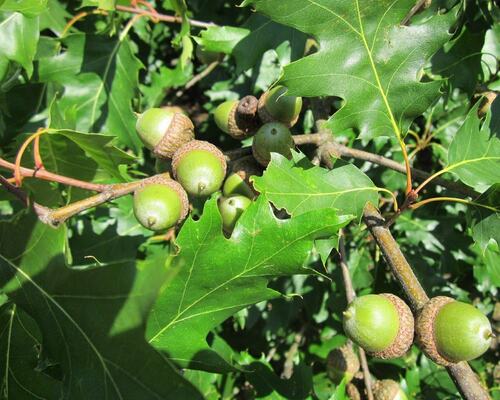
Leaves & Acorns of an Oak Tree – Photo by Wikimedia Images on Pixabay
Native trees are often the best choice for wildlife gardens. They’re adapted to local conditions and provide familiar food and shelter for native wildlife. However, some nonnative species can also be beneficial, especially in challenging urban environments.
Top 5 Tree Species for Urban Wildlife Gardens
- Oak : Oak trees can support over five hundred species of caterpillars and many kinds of birds.
- Maple : Maple trees provide seeds for birds and small mammals.
- Dogwood: Dogwood trees offer fruit for birds and beautiful flowers for pollinators.
- Crabapple : Crabapple trees attract birds with their fruit and bees with their blossoms.
- Birch: Birch trees host many kinds of insect species and provide seeds for birds.
Considerations for Small Spaces
Don’t let a small yard deter you! There are still many options you can consider:
- Dwarf tree varieties
- Multi-stemmed trees
- Columnar trees for narrow spaces
- Espalier techniques for training trees against walls
Remember, even a single well-chosen tree can make a significant impact on urban wildlife!
With your trees selected, it’s time to focus on proper planting and maintenance to ensure they thrive in your urban environment.
Planting and Maintaining Your Urban Wildlife Trees
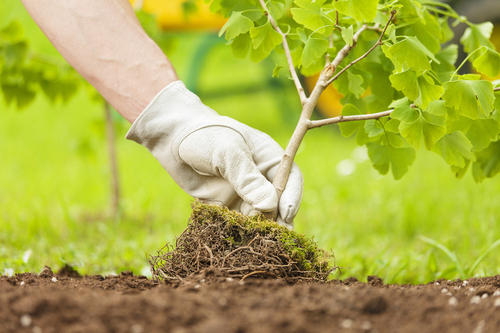
A Sapling Being Planted in Fresh Soil
Proper planting and care are essential for the health of your urban wildlife trees. A well-maintained tree will be more resilient and better able to support a diverse array of wildlife. Here’s what you need to know:
Best Practices for Tree Planting
- Choose the right location, considering mature size and sunlight requirements
- Dig a hole twice as wide as the root ball but no deeper
- Gently loosen the roots before planting
- Backfill with native soil , avoiding excessive amendments
- Water thoroughly and apply mulch, keeping it away from the trunk
Watering and Fertilizing Tips
- Water deeply but less frequently to encourage deep root growth
- Use slow-release, organic fertilizers to avoid chemical runoff
- Consider installing a drip irrigation system for efficient watering
Pruning Techniques to Encourage Wildlife
- Avoid overpruning—a slightly messy tree is more wildlife friendly!
- Leave dead branches when it’s safe to do so, as they provide homes for insects and birds.
- Prune in late winter or early spring to minimize the impact on nesting wildlife.
Dealing with Common Urban Tree Pests and Diseases
- Monitor trees regularly for signs of stress or infestation
- Use organic pest control methods when possible
- Consult a certified arborist for severe issues
Remember, a healthy tree is more resilient and better able to support wildlife!
While trees form the backbone of your urban wildlife garden, the understory plays a crucial role in creating a complete habitat. Let’s explore how to enhance your garden’s biodiversity by focusing on the layers beneath your trees.
Creating a Wildlife-Friendly Understory
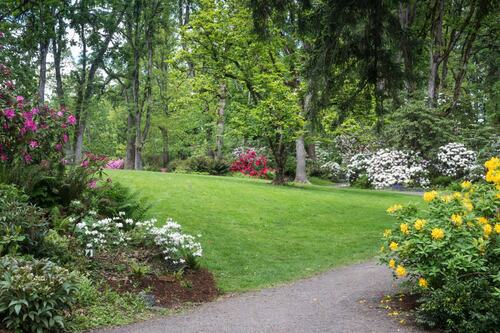
A Lush, Wild Area Filled with Trees and Flowers
A diverse understory is key to a thriving urban wildlife garden. It provides additional food sources, shelter, and nesting sites for a variety of species. Here’s how to create a rich, layered habitat:
Companion Plants for Your Trees
- Native shrubs like elderberry or viburnum
- Wildflowers like coneflowers and black-eyed Susans
- Ferns and native grasses for ground cover
Layering Vegetation for Maximum Habitat
Create a multilayered habitat by including:
- Canopy (tall trees)
- Understory (smaller trees and larger shrubs)
- Shrub layer
- Herbaceous layer (flowers and grasses)
- Ground cover
- Root zone
This layering mimics natural forest structures and provides diverse habitats for different species.
Incorporating Water Features
Water is a magnet for wildlife. Consider adding:
- A small pond or water garden
- A bird bath or shallow water dish
- A rain garden to manage stormwater runoff
Using Fallen Leaves and Branches
Don’t be too tidy! Fallen leaves and branches are valuable for wildlife:
- Leave leaf litter as natural mulch and insect habitat
- Create brush piles for small mammals and birds
- Use logs as natural borders and beetle habitats
With your trees planted and your understory established, it’s time to focus on specific ways to attract a diverse array of wildlife to your urban oasis.
Attracting Diverse Wildlife to Your Urban Garden
Now that you’ve set the stage, it’s time to roll out the welcome mat for wildlife! By providing for the specific needs of different species, you can create a bustling ecosystem in your backyard.
For the Birds
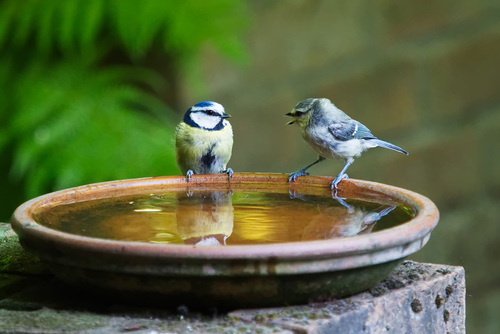
A Birdbath Hosts Chattering Birds – Photo by Aitoff on Pixabay
- Install a variety of bird feeders with different types of seeds
- Provide nesting boxes appropriate for local bird species
- Offer bird baths with moving water to attract more species
For the Pollinators
- Plant nectar-rich flowers that bloom throughout the season
- Create a “bee hotel” with hollow stems and drilled wood blocks
- Leave some bare soil for ground-nesting bees
For Small Mammals
Install squirrel feeders away from bird feeding areas
Create hedgehog houses with piles of leaves and branches
Provide safe corridors between different parts of your garden
For Amphibians and Reptiles
Create rock piles for basking and shelter
Ensure easy access in and out of water features
Avoid using chemicals that might harm sensitive amphibian skin
Remember, patience is key. It may take time for wildlife to discover your garden, but once they do, you’ll have front-row seats for nature’s show!
As your garden becomes a hub of wildlife activity, it’s important to consider how to balance the needs of your wild visitors with those of your human household and your neighbors.
Balancing Wildlife and Human Needs in Your Garden
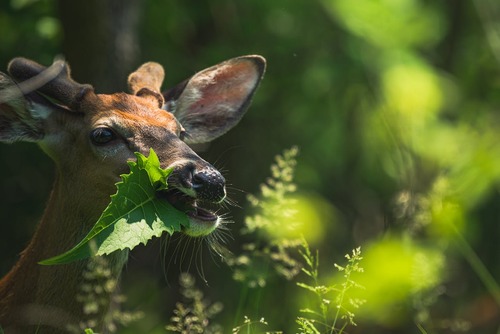
A Deer Munches on Foliage – Photo by Chris F on Pixabay
Creating a wildlife-friendly garden doesn’t mean sacrificing your enjoyment of the space. With some thoughtful planning, you can create a harmonious environment that benefits both wildlife and humans. Here’s how to strike that balance:
Managing Potential Conflicts with Neighbors
- Communicate with neighbors about your wildlife garden goals
- Keep trees pruned to prevent overhanging branches
- Ensure that wildlife feeding doesn’t attract pests
Ensuring Safety for Both Wildlife and Humans
- Use wildlife-friendly lighting to reduce light pollution
- Avoid using pesticides and herbicides
- Keep cats indoors or supervised to protect birds and small mammals
Incorporating Recreational Spaces
- Create winding paths through your wildlife areas
- Install seating areas for wildlife watching
- Use native plants in your vegetable or herb garden to serve both wildlife and your kitchen
Educating Others About Your Urban Wildlife Garden
- Host garden tours to share your knowledge
- Participate in citizen science projects to monitor urban wildlife
- Consider getting your garden certified as a wildlife habitat
By finding this balance, you can create a space that’s not only a sanctuary for wildlife but also a source of joy and education for you, your family, and your community.
Conclusion: Your Urban Wildlife Oasis Awaits!
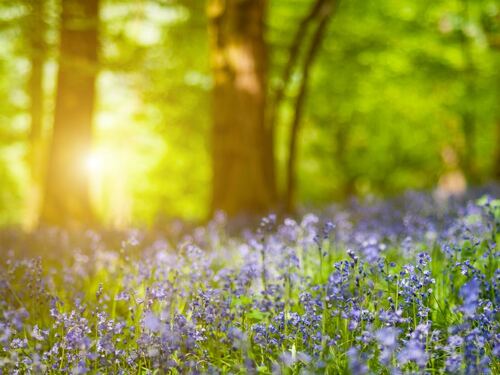
A Patch of Wildflowers Near a Forest
Creating a wildlife-friendly urban garden with trees is an exciting journey that brings nature right to your doorstep. By carefully selecting and maintaining the right trees, creating a diverse understory, and providing for wildlife needs, you’re not just beautifying your space—you’re making a real difference in urban conservation efforts.
Remember, every leaf and branch counts in creating a thriving ecosystem. Your efforts contribute to the larger picture of urban wildlife conservation, creating a network of green spaces that support biodiversity across our cities.
So, why wait? Start planning your urban wildlife garden today. Whether you have a sprawling backyard or a tiny balcony, there’s always room to welcome wildlife. Your future feathered, furry, and leafy friends will thank you—and you’ll be rewarded with a vibrant, ever-changing natural spectacle right outside your window. Happy gardening!
We may receive affiliate compensation for some of the links below at no cost to you if you decide to make a purchase.


